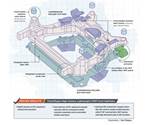CFRP use expanded in Porsche 911 GT3
Bigger than its predecessor, but with only a slight increase in mass thanks to light weight body panels.

The 2022 Porsche 911 GT3 has a top speed of 197 mph. Photo Credit: Porsche
Although the seventh generation of the Porsche 911 GT3 has an increased front track of 1.9 inches compared with its predecessor, the curb weight of the 2022 model is still a light 3,157 pounds, and only slightly heavier (4 pounds) than the previous generation (3,153 pounds). That weight increase would have been much greater if the company had not made more extensive use of carbon fiber-reinforced plastics (CFRP) in the vehicle.
The hood, rear wing, and fixed wing are all CFRP. A carbon fiber roof is optional, as are carbon fiber mirror caps. Another weight-saving option are full carbon seats: Compared to the standard seats in the 911 GT3, the composite seats represent a 26-pound mass reduction.
The 2022 Porsche 911 GT3, which is to become available in the U.S. in the fall, is fitted with a 502-horse power, 4.0-liter engine that propels the car from 0 to 60 miles per hour in 3.2 seconds. Top speed: 197 miles per hour.
Related Content
-
Plant tour: Aernnova Composites, Toledo and Illescas, Spain
RTM and ATL/AFP high-rate production sites feature this composites and engineering leader’s continued push for excellence and innovation for future airframes.
-
Plant tour: Airbus, Illescas, Spain
Airbus’ Illescas facility, featuring highly automated composites processes for the A350 lower wing cover and one-piece Section 19 fuselage barrels, works toward production ramp-ups and next-generation aircraft.
-
Plant tour: Collins Aerospace, Riverside, Calif., U.S. and Almere, Netherlands
Composite Tier 1’s long history, acquisition of stamped parts pioneer Dutch Thermoplastic Components, advances roadmap for growth in thermoplastic composite parts.
.jpg;width=70;height=70;mode=crop)


